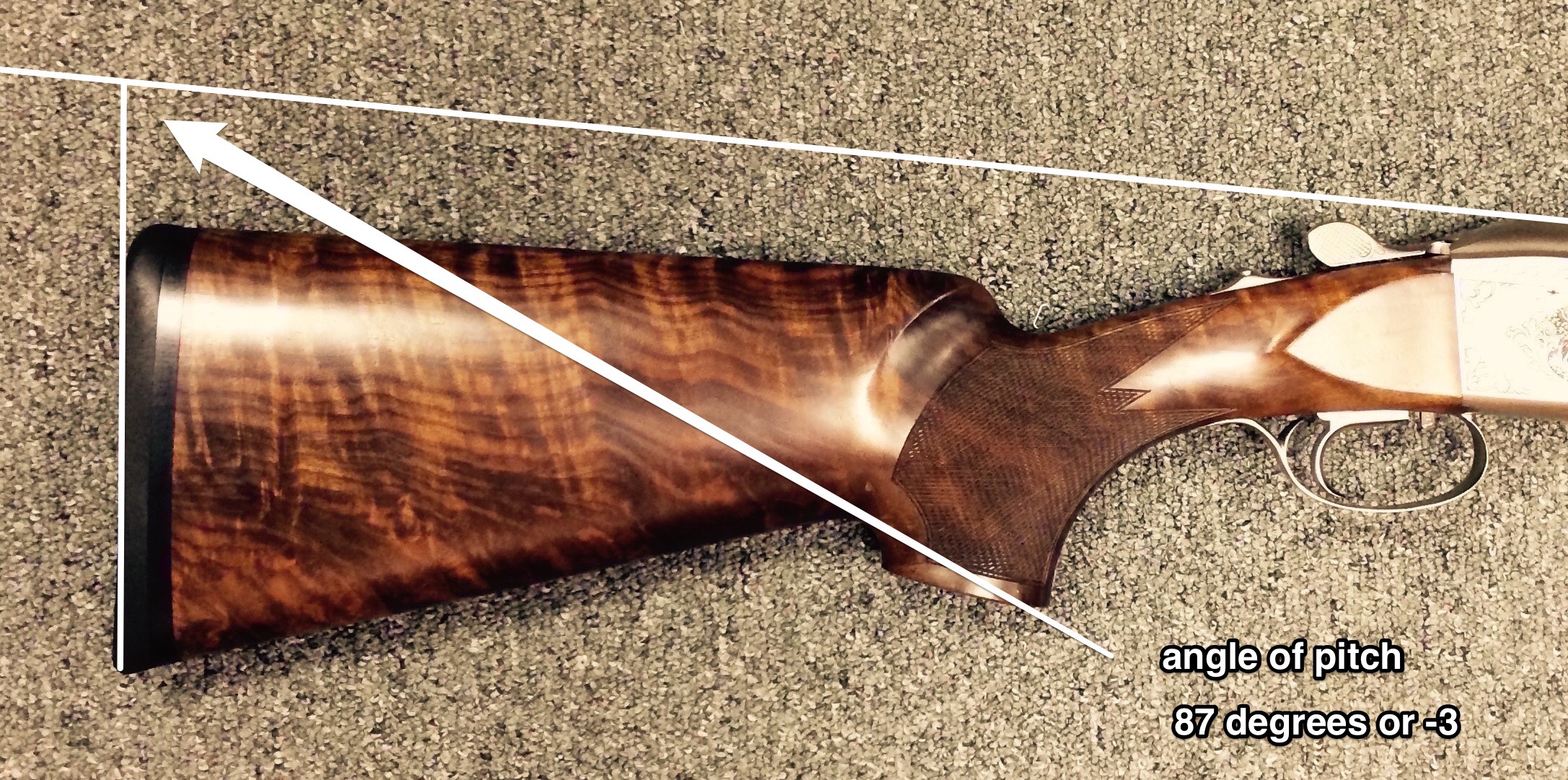-
Stock Fit. Part II. Length and Pitch
The right stock fit is a length that allows you to mount the gun consistently and easily. If you have to stretch to get the gun in the shoulder it is too long. If you bump your nose with the heel of your thumb it is too short. There is no need to make it more complicated than that. If you stand fairly square to the target you will need a shorter stock than someone who mounts across the body, rifleman style. Some will stock crawl, meaning they crane their head and neck forward until they are right on the front of the comb. Not a good technique and long term is likely to be responsible for recoil damage to the neck. A relaxed head up style is the most natural and the most consistent. As a general guide you should have about two fingers width between the nose and the base of the thumb. A stock that is slightly short is easier to shoot than one that is a little long.
Stock length is measured from the front of the trigger blade to the back of the recoil pad. Many guns have moveable trigger blades so always take measurements by first putting the trigger in the neutral position. This will vary from maker to maker but is normally obvious when you look. If you are not able to move the trigger make sure you note alongside the measurement the position the trigger blade was in when you measured.
Pitch, sometimes called “stand” is a measurement that primarily delivers comfort and control of recoil. For those who don’t know, pitch is the vertical angle of the face of the butt, normally measured in relation to the top line of the rib.
Traditionally it is not referred to at all and the dimension is specified by means of stating the length at heel, centre and toe. If those three dimensions are specified they determine the angle of the face of the pad and therefore the pitch. In recent times it has been more common to see the pitch measurement stated as an angle relative to the rib. A neutral pitch would be at an exact right angle to the top of the rib and would be written as 90 degrees or 0. Slight down pitch of say 3 degrees would be written as -3 or 87 degrees. This is an exact and very precise way of stating the pitch.
The older term, “stand” was arrived at by standing the gun on the floor, breech end of the rib against the wall and measuring how much the muzzle stood out from the wall. This was a quick visual guide but pretty hopeless for stock making purposes as the stand varied with the barrel length and other factors.
Today many guns feature adjustable ribs and this creates a new problem. If the rib is raised or lowered at the front the angle of the rib in relation to the face of the pad changes. This gives a new and changed dimension for the pitch angle. We need to remember this when taking stock dimensions from a gun with an adjustable rib.
Pitch is only comparable between identical guns because different rib styles, including adjustable ribs, make direct comparison difficult, if not impossible. A very experienced stock fitter may be able to interpret pitch measurement onto a different gun but it is always preferable to compare like with like.
It is often said that down pitch will make a gun shoot low due to the tendency of the muzzle to dip when the toe of the stock is unsupported. I have pattern tested many guns with down pitch and adjustable pitch and I have never found that changing the pitch makes the slightest difference to point of impact. The muzzle does dip, or climb depending on the pitch but by the time this happens the shot has already left the barrel and point of impact is therefore unaffected.
As stated at the beginning, pitch is a measurement that governs comfort and helps control recoil. The ideal pitch dimension is that which puts 100% of the surface of the pad in contact with the shooter’s shoulder. If the gun is supported over the whole face of the pad the load will be spread evenly and the recoil will tend to be in a straight line.
To establish what pad contact you have, pull the gun back hard into the shoulder and try to feel the pad contact. The load should be even and not concentrated at either toe or heel. Ideally, ask a knowledgeable friend to take a look and see if the toe and heel of the pad are both in contact and that both have a more or less equal weight on the shoulder. It is worth spending some time to get this right and whilst doing so look for a pad that has even hardness across the whole face and avoid those that are soft in the middle section but hard at toe and heel. When the recoil pushes back we want the whole face of the pad to be taking the load.
A common mistake is to take too much off the toe leaving only the top half or third of the pad in solid contact with the shoulder. The result is increased recoil and a tendency for the muzzle of the gun to dip under recoil.
Changing the pitch does have a dramatic effect on comfort and a gun that was punishing the shooter can be transformed by a small change of only 2 or 3 degrees. Pitch is a dimension worth paying attention to if only for this reason.
Share this:







I want to be the first to thank you for this. Its just what I want after you stopped your column in Clayshooting Magazine. Keep up the good work, looking forward to more.